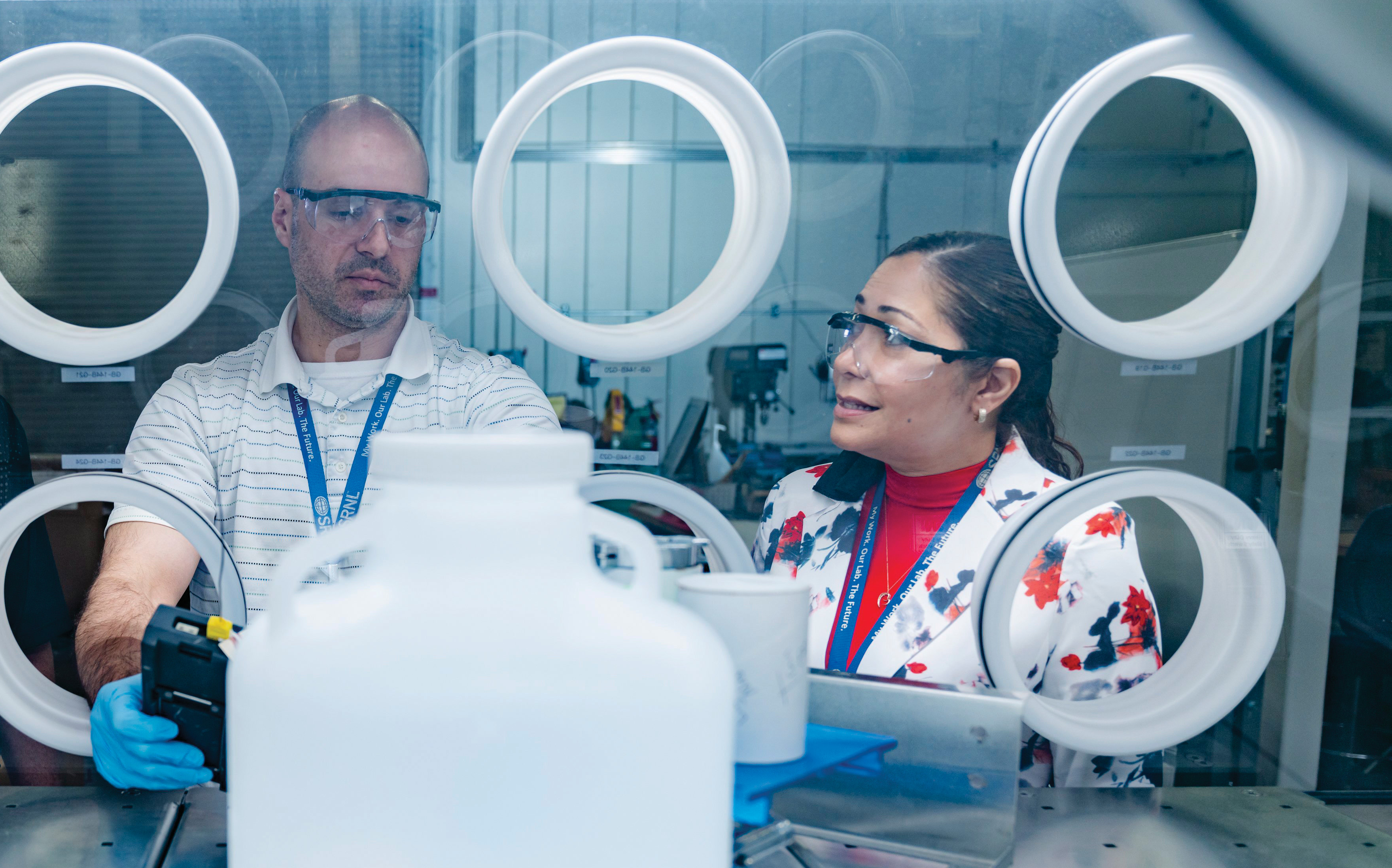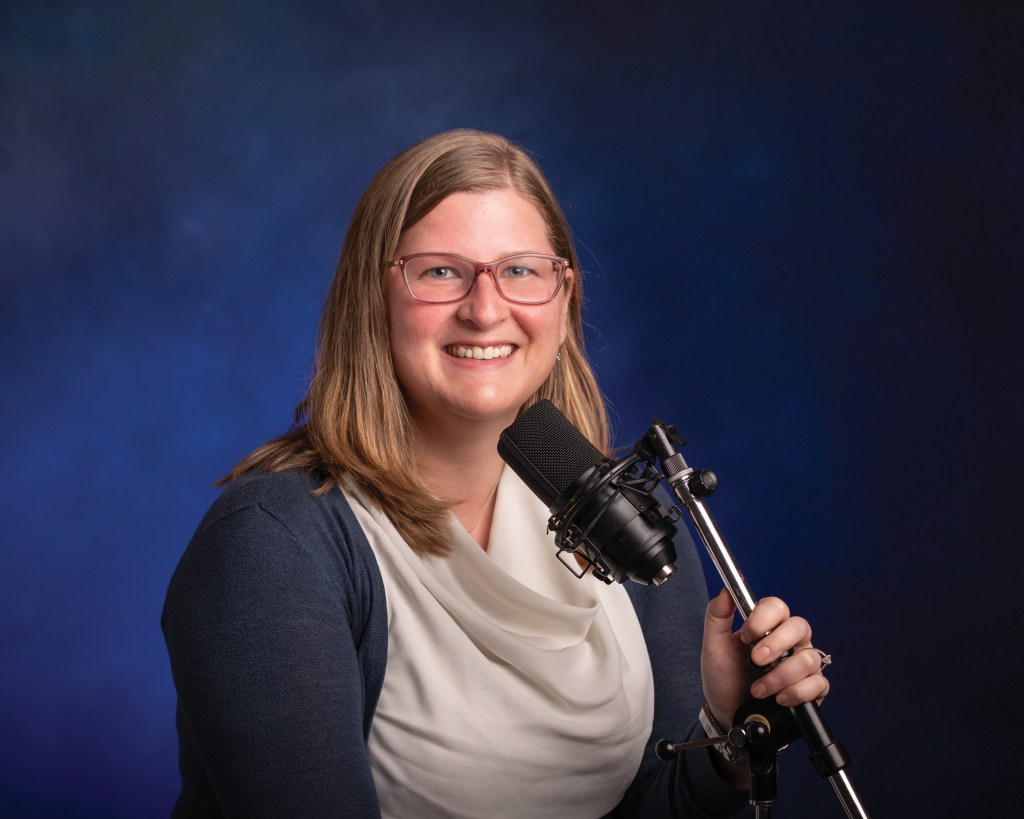“The fuel cycle can indeed be viewed as a ‘cycle in a box’ that will be useable by the entire fusion community.” – Dale Hitchcock

Paul Beaumont (left) and Brenda Garcia-Diaz (right) in SRNL’s fusion laboratory. (Photo: LJ Gay, SRNS)
While the future is always said to be uncertain, one certainty is that the world’s demand for energy will continue to grow. An increasing population, burgeoning transportation grid, large data centers and other factors are pressuring scientists to develop new energy technologies to meet the demand. As these new energy sources take shape, it’s paramount that they be affordable and efficient.
At the top of the list of new sources of power is fusion energy. The same type of energy that powers the sun, fusion occurs when the nucleus of one atom fuses with the nucleus of another atom, and a tremendous amount of energy is released. Scientists’ knowledge and understanding of fusion is not new. The concept has been used in nuclear weapons since the early days of the Cold War. However, harnessing fusion as an everyday source of power is another matter. Commercial use of fusion does not yet exist.
However, a collaborative of chemists, engineers and nuclear scientists led by Savannah River National Laboratory looks to change this. The U.S. Department of Energy Fusion Energy Sciences program has a goal of realizing viable commercial fusion energy as soon as possible, and recently announced the funding of six Fusion Innovation Research Engine (FIRE) collaboratives. Among the winners was FC-FIRE – SRNL’s collaborative – which is tasked with developing the fusion fuel cycle. FC-FIRE consists of experts from five national laboratories, nine universities and one private company, as well as industry associations and international partnerships. It will be led by SRNL’s Brenda-Garcia Diaz, director and lead principal investigator, and George Larsen, deputy director.
Commercial fusion energy is an incredibly complex endeavor that involves a multitude of phases, processes, technologies and facilities, all of which must integrate seamlessly. Like any form of energy, fusion needs fuel, and that fuel goes through a cycle from its origins to providing energy to becoming spent waste. FC-FIRE is tasked with seeing that cycle through to completion.

Although fusion can occur via a handful of different fuels, the fuel of choice is tritium, an isotope of hydrogen. SRNL is the logical choice to take the lead in this area. It has more than 60 years of experience in tritium research and is the design authority for the processes at Savannah River Site’s Tritium Facilities.
“SRNL’s core competencies in hydrogen isotope processing, isotope separation, and purification technologies, gained from decades of experience in the U.S. defense program, are directly applicable to the [tritium] fuel cycle,” said Garcia-Diaz.
Tritium has low radioactivity, and SRNL has facilities for handling, storing and characterizing radiological and tritium-exposed materials. SRNL is completing the Advanced Manufacturing Collaborative on the USC-Aiken campus, which will provide modern, dedicated project space. Moreover, SRNL is leading the design and fabrication of the Tokamak Exhaust Processing system for the International Tokamak Experimental Reactor (ITER), a massive fusion device currently under construction in France. The lab has successfully completed several other tritium-related projects in recent years.
The fusion fuel cycle is a multi-step process, and all of the steps will work in concert. The project partners were assembled based on their expertise with these different processes, which FC-FIRE organized into six different “thrusts.” Leads for each thrust are principal investigators from across the collaborative that bring specific skills and experience to the project, and they will all serve on the FC-FIRE Executive Committee.
A sprawling team of diverse partners that is geographically scattered could create logistical and communication issues. SRNL is confident it can overcome these challenges. “Building a cohesive team culture across different locations requires deliberate effort,” said Garcia-Diaz. “We plan to utilize state of the art technology and frequent virtual meetings to support meaningful and efficient remote collaboration.”

Brenda Garcia-Diaz (second from right) and colleagues in SRNL’s fusion laboratory. (Photo: LJ Gay, SRNS)
FC-FIRE will ultimately reach several milestones and produce a myriad of tangible products. To begin with, it will produce an integrated, open-architecture process model for the fusion fuel cycle. This will include all aspects of tritium from start to finish and, as a whole, can be integrated into a wide variety of commercial fusion applications. Commercial fusion companies can use this fuel cycle when designing and optimizing fusion plant systems going forward.
“The fuel cycle can indeed be viewed as a ‘cycle in a box’ that will be useable by the entire fusion community,” said Dale Hitchcock, SRNL scientist.
FC-FIRE will also develop component-level models, tritium experimental data, and advanced, highly durable fusion materials. The economic viability of the technologies involved is critical, so techno-economic analyses will also be conducted for various processes in the fuel cycle.
The sustained success of commercial fusion is not only dependent on technological development, but the hands and minds to implement and improve that technology. If commercial fusion is to revolutionize the energy industry, it will need a new generation of trained workers. Thus, FC-FIRE will prioritize fusion workforce development, both at SRNL and across all partner organizations.
“A quantitative measure of success will be the number of individuals trained and engaged in the fusion fuel cycle R&D, as well as their retention within the fusion ecosystem,” Garcia-Diaz emphasized.
A prime example is SRNL’s Holly Flynn. She is a recent recipient of DOE’s Early Career Scientist Award. Flynn has done innovative work on modeling of tritium accounting in the fusion fuel cycle. Retention of talent like Flynn in the fusion community will be paramount. To this end, FC-FIRE will develop an Early Career Network of young workers as the project progresses.
Early career scientists will learn and mentor from experts in the field in the national labs, universities and industry. From this wealth of knowledge and talent, groundbreaking achievements in fusion will hopefully spring. The FC-FIRE team is certainly big, but so is the payoff for world’s energy demand.

Holly Flynn describes her fusion research on the SRNL podcast Science at Work. Click here to listen to the episode.